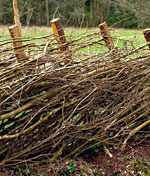How to lay a hedge
The National Hedge Laying Society explains how to create and lay your own hedge


How do I start?
Consider what you need the hedge for:
1. If it’s purely to contain livestock, use prickly plants, hawthorn (quicks) and blackthorn, as animals are deterred by them.
2. If it needs to be stockproof, as well as a shelter for stock (and wildlife), use a base of hawthorn and blackthorn, with an occasional holly and/or beech (which retain dead leaves through the winter). Never include elderberry or sycamore as, although they grow fast and lay well, they kill all other plants. Ash grows fast, but makes an edible hedge; field maple is also edible and brittle to lay; oak is slow growing and edible; hazel lays well, but doesn’t last long; rose is often eaten.
3. For a boundary marker, which will be colourful and not near any animals, your choice is wide, as almost any shrub or small tree, apart from firs, will lay. Use those that grow best in your area, so there are some leaves/flowers/stems visible all year round.
Ground preparation
If possible, dig (or plough a couple of furrows) on the hedge line and incorporate well-rotted manure in spring/summer, allowing the soil to settle in autumn/early winter, then plant up January/February. If you have to dig holes and plant at the same time, dig the hole deeper than needed, put a dollop of manure in the bottom and cover it with soil before putting the plant in. Manure ‘burns’ young roots, but they will find it when needed, by which time worms will have mixed it well with the soil.
Exquisite houses, the beauty of Nature, and how to get the most from your life, straight to your inbox.
Buying plants
Garden centres charge a lot for a few. Consult the agricultural press in January and find firms that sell plants in large batches. The plants are bare-rooted. If they arrive during frost or snow, put them in a plastic bag, shake potting compost around them, water well and keep in a frost-proof place until conditions improve. Once in a gag, it’s an idea to remove the wire or string from around the plants. The 12in–18in plants transplant better, but for a quicker result, use 2ft–3ft plants. You can plant in either a single or double row, trees spaced about 9in apart. If in a double row, plants should be staggered.
Planting
Ensure roots are well spread and plants firmly pressed in.
Protecting
The plants must be kept safe by a fence each side (wire or electric), about 3.5ft away or very high. You can buy tubes for individual plants to protect them, but it gets expensive.
Caring for the hedge
Keep weeds from smothering the plants, but a little grass around the base will protect the roots from hot sun or hard frost. The sides can be trimmed, but the top must be left alone. The hedge is ready to lay when it’s a minimum of twice the height of the laid hedge (so, for example, if the hedge will be 4ft, it must be at least 8ft tall before laying). It is size, not age, that determines when a hedge is ready to lay.
What does a hedge cost?
It’s not possible to have standard charges for hedge laying: if the hedge is overgrown, 20ft high and gappy, an expert could do three or four yards a day. A new hedge, clear of weeds, about 8ft–10ft tall, would allow a man of average skill to do about 30 yards a day. Labour is only part of the cost. Unless the client buys the stakes and binders and places them on site, the hedge-layer will charge the cost of buying and transporting them. You may have a wood on your land from which they may be cut, but the time the layer spends cutting them will be charged. The work is expensive, but a trimmed hedge can last 50 years before it has to be relaid. A good average is 15-20 years.
Different styles
Types depend on the animals kept in, the climate and how the plants grow in the area. Usually, the side of the hedge towards the road‘the front’ has the stems, that animals chew, showing. The twiggy ends are put to the animals’ side, to protect the stems. Big animals, such as bullocks or horses, can lean on hedges. Unless the hedge is tall, about 4½ft, laid away from the roots towards the animals with close, well-driven stakes and has a binding on top, the hedge can be broken, or even jumped.
Sheep usually push through the base of a hedge, so stems must be close at the bottom, sometimes with dead wood pushed into the ground on each side. In windy areas, hedges tend to be laid low, with a few living stems left as stakes to anchor the hedge. In snowy places, twigs are laid with a rounded top so the snow slides off.
Country Life is unlike any other magazine: the only glossy weekly on the newsstand and the only magazine that has been guest-edited by His Majesty The King not once, but twice. It is a celebration of modern rural life and all its diverse joys and pleasures — that was first published in Queen Victoria's Diamond Jubilee year. Our eclectic mixture of witty and informative content — from the most up-to-date property news and commentary and a coveted glimpse inside some of the UK's best houses and gardens, to gardening, the arts and interior design, written by experts in their field — still cannot be found in print or online, anywhere else.
